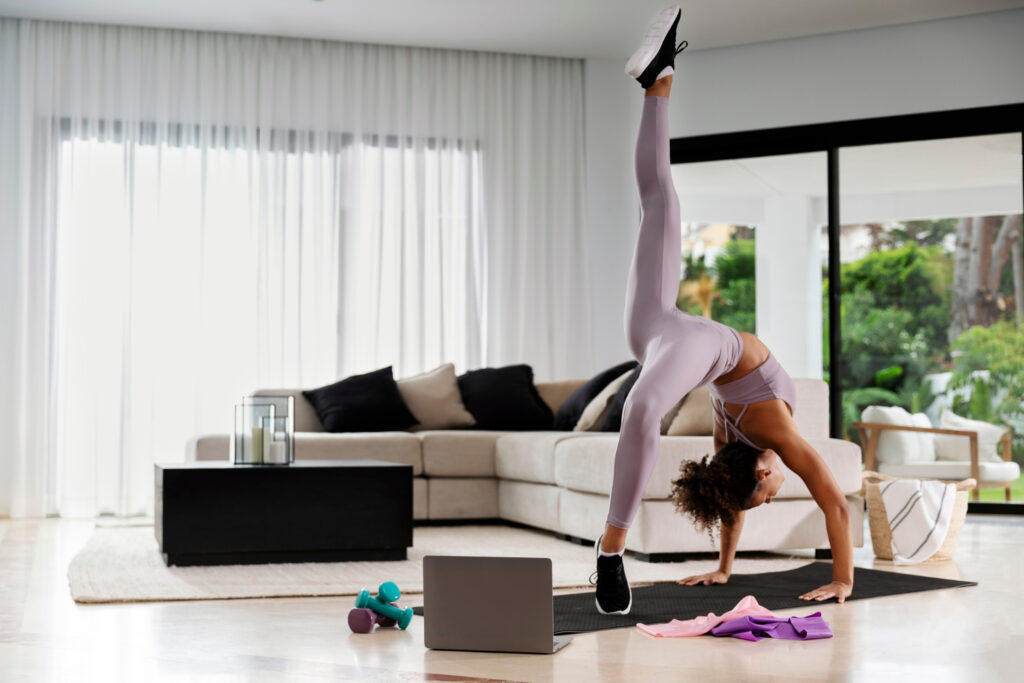Introduction
Maintaining a fitness routine can be challenging, especially for those with busy schedules. However, with the right approach, it’s entirely possible to achieve an effective workout regimen at home. This guide will explore various strategies and exercises designed to help you stay fit without the need for a gym membership, ensuring you can work out anytime, anywhere.
Benefits of Home Workouts
Home workouts offer several significant advantages. Firstly, they are incredibly convenient. You can exercise at any time that suits you, without the need to travel to a gym. This flexibility is particularly beneficial for those with hectic schedules. Secondly, home workouts are cost-effective. There are no membership fees, and minimal equipment is required. Lastly, the privacy of working out at home can be more comfortable for many, allowing for a more relaxed and personalized fitness experience.
Planning Your Home Workout Routine
Creating an effective home workout routine involves setting clear fitness goals. Decide what you want to achieve—whether it’s weight loss, muscle gain, or overall fitness. Choose a time that fits seamlessly into your daily routine, and dedicate a specific space in your home for exercise. This space should be free from distractions and have enough room for you to move comfortably.
Essential Equipment for Home Workouts
While home workouts can be done with minimal equipment, having some basic gear can enhance your routine. Consider investing in a yoga mat, resistance bands, a jump rope, and a set of dumbbells. These items are versatile and can be used for a variety of exercises, allowing you to target different muscle groups effectively.
Bodyweight Exercises
Bodyweight exercises are a cornerstone of home workouts. They require no equipment and can be done anywhere. Key exercises include push-ups, squats, and lunges. These movements engage multiple muscle groups and help build strength and endurance.
Push-ups work the chest, shoulders, triceps, and core. Start with a standard push-up and modify as needed by performing them on your knees or elevating your hands on a sturdy surface.
Squats target the legs and glutes. Ensure your feet are shoulder-width apart and keep your back straight as you lower yourself down.
Lunges work the legs and improve balance. Step forward with one leg and lower your hips until both knees are bent at a 90-degree angle.
Cardio Workouts at Home
Cardio exercises are essential for heart health and calorie burning. Effective home cardio workouts include jumping rope, high knees, and burpees.
Jump rope is an excellent full-body workout that improves cardiovascular endurance. Aim for short bursts of high-intensity jumping followed by rest periods.
High knees involve running in place while lifting your knees as high as possible. This exercise increases your heart rate and works the core and leg muscles.
Burpees combine a squat, push-up, and jump, making them a comprehensive exercise that targets multiple muscle groups and boosts cardiovascular fitness.
Strength Training at Home
Strength training is crucial for building and maintaining muscle mass. You can effectively train at home using dumbbells, resistance bands, and kettlebells.
Dumbbells are versatile and can be used for various exercises like bicep curls, shoulder presses, and chest presses.
Resistance bands provide adjustable resistance for exercises such as rows, chest flies, and leg extensions.
Kettlebells are great for dynamic movements like swings, goblet squats, and Turkish get-ups, which build strength and enhance stability.
High-Intensity Interval Training (HIIT)
HIIT involves short bursts of intense exercise followed by brief rest periods. This method is highly effective for burning calories and improving cardiovascular fitness in a short amount of time.
A sample HIIT routine might include 30 seconds of jumping jacks, 30 seconds of rest, 30 seconds of burpees, and 30 seconds of rest. Repeat this cycle for 15-20 minutes for a full workout.
Yoga and Flexibility Exercises
Yoga is beneficial for both the body and mind, enhancing flexibility, strength, and relaxation. Incorporate basic yoga poses like downward dog, warrior, and child’s pose into your routine.
Stretching exercises are also important for preventing injuries and improving range of motion. Spend a few minutes stretching after your workouts to cool down and maintain flexibility.
Creating a Balanced Workout Plan
A balanced workout plan includes a mix of cardio, strength training, and flexibility exercises. This combination ensures you’re working all aspects of fitness, from endurance to muscle tone to joint health.
For example, you could do cardio on Mondays, strength training on Wednesdays, and yoga on Fridays. Adjust the plan based on your goals and preferences, ensuring you get adequate rest between intense sessions.
Time-Saving Workout Strategies
Busy schedules require efficient workout strategies. Circuit training, where you perform a series of exercises back-to-back with minimal rest, can save time while providing a full-body workout.
Supersets, which involve alternating between two exercises that target different muscle groups, also maximize efficiency. Micro workouts, such as short bursts of exercise throughout the day, can add up to significant fitness benefits without requiring a large time commitment.
Incorporating Workouts into Daily Activities
You can turn everyday activities into exercise opportunities. Desk exercises like seated leg lifts or arm circles can be done while working. Household chores like vacuuming or gardening also count as physical activity.
Look for creative ways to stay active throughout the day. Take the stairs instead of the elevator, or do a few squats while waiting for your coffee to brew.
Staying Motivated
Maintaining motivation is key to a successful fitness routine. Set realistic, achievable goals and track your progress. Celebrate milestones to stay encouraged.
Finding a workout buddy can also enhance motivation. Partnering with someone can make workouts more enjoyable and add a level of accountability.
Nutrition for Busy People
Good nutrition is essential for supporting your workout efforts. Focus on quick and healthy meal ideas that fit into a busy lifestyle.
Prepare meals in advance, choose nutrient-dense foods, and stay hydrated. Simple snacks like fruits, nuts, and yogurt can provide energy without requiring extensive preparation.
Safety Tips for Home Workouts
Safety should always be a priority. Start each session with a warm-up to prepare your muscles and joints for exercise. Cool down with stretching to aid recovery.
Use proper form to avoid injuries, and listen to your body. If something feels painful or uncomfortable, stop and adjust the exercise.
Workout Apps and Online Resources
Technology can be a great aid in your fitness journey. There are numerous workout apps and online resources available to guide you.
Popular apps like MyFitnessPal, Nike Training Club, and YouTube channels like Fitness Blender offer a variety of routines and tips. Online communities provide support and motivation.
Managing Stress Through Exercise
Exercise is a powerful tool for managing stress. Physical activity releases endorphins, which improve mood and reduce anxiety.
Incorporate stress-relief exercises such as deep breathing, meditation, or leisurely walks. These practices can complement more intense workouts and contribute to overall well-being.
Adapting Workouts to Different Fitness Levels
It’s important to adapt workouts to your fitness level. Beginners should start with simple exercises and gradually increase intensity. Intermediate and advanced individuals can challenge themselves with more complex movements and higher weights.
Modify exercises as needed to match your abilities, ensuring you stay safe and effective in your training.
Home Workouts for Specific Goals
Different goals require different approaches. For weight loss, focus on high-intensity cardio and calorie-burning exercises. For muscle gain, prioritize strength training with progressive overload.
Overall fitness goals can be achieved with a balanced mix of cardio, strength, and flexibility training.


